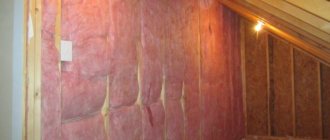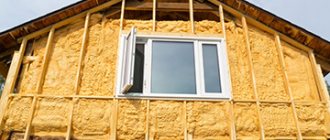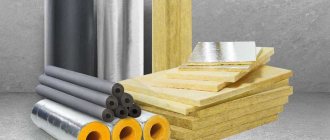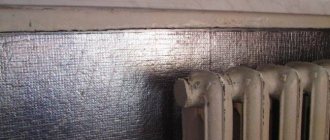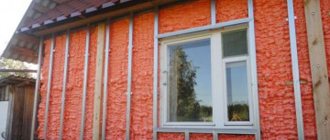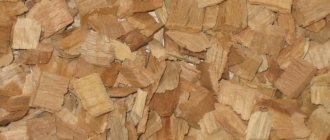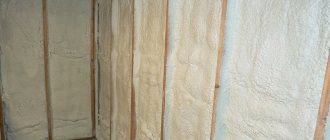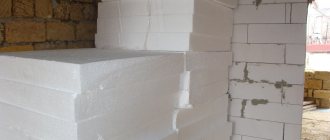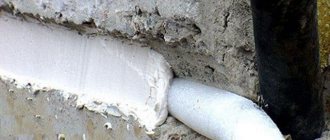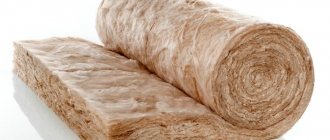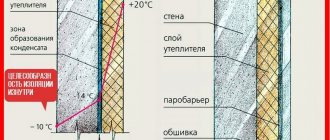Is it possible to insulate walls with foam?
It is widely used for insulating walls outside and inside.
Apply using a special apparatus or a pistol. The material fits well on vertical, horizontal and inclined surfaces. Features of wall insulation:
- The walls become thicker, which leads to greater resistance from environmental influences.
- The material can withstand temperatures up to +80.
- Vapor permeability.
- Resistant to various damages. It will not crumble from impact or become deformed.
- The material does not burn.
The following objects are insulated:
- window openings;
- walls from the street;
- foundation;
- balcony, attic;
- pipelines;
- attic spaces.
After application there are no seams or joints. The foam hardens in 1 to 3 days, depending on the number of layers applied.
Inside
Warming indoors is carried out as a last resort.
Only when it is not possible to carry out work, if the apartment is on the upper floors. This is indicated in SNiP 23-101-2004. When insulating walls indoors, you should take care of waterproofing, because the dew point shifts. The walls will be wet, which will lead to the appearance of fungus and destruction of the supporting structure.
Outside
Insulating the outside is the right solution. The main factor is not the violation of the dew point. The walls will be warm and dry.
Benefits of insulating from the outside:
- High energy saving data.
- Inside, the footage remains the same.
- No condensation.
- Sound insulation performance improves.
Disadvantage: foam insulation requires the use of equipment.
Even with the inflated cost of the materials, the equipment used, and the work of the craftsmen, this pays off in savings (payment for heat), silence, and comfort.
Liquid foam
This type of insulation includes almost all foam materials based on polymer resins. The quality of the final product, including its environmental friendliness, largely depends on them. There are raw materials whose use is not permissible for residential premises due to the high toxicity of the polymer and its long-term emissions. At the same time, such materials are quite suitable for insulating technical structures or isolated building elements (if there is confidence in their insulation and the conscientiousness of the working specialists).
At the moment, such types of liquid foam as polyurethane foam, penoizol, as well as a number of products in compact cylinders are common.
Polyurethane foam (PPU)
Viscous heterochain polymers in a liquid state are used as the main component of this insulation. During chemical reactions, urethanes foam, which leads to their increase in volume by more than 50 times.
In its frozen state, polyurethane foam resembles ordinary polyurethane foam, the main difference in the structure is less porosity.
Mainly used for:
- Insulation of walls of frame buildings;
- Roofing structures;
- House facades;
- Thermal insulation of basements and lower floors.
To apply polyurethane foam, you need a special unit that first mixes and foams the insulation components, and then delivers the finished mixture under pressure to the surface to be treated.
Final polymerization occurs within 24 hours, after which the finishing can be installed. Polyurethane foam is suitable for treating surfaces made of brick, concrete, wood, metal, cinder blocks and gas silicate blocks.
The average cost of work including material is 1000-1500 rubles per m2, with a layer thickness of 50 mm.
Penoizol
A budget analogue of polyurethane foam insulation, since it is based on relatively cheap, but more toxic urea-formaldehyde resin. The structure of this insulation is very similar to ordinary foam plastic, but its use is more preferable due to the absence of cold gaps in the insulating layer, characteristic of sheet and roll materials.
The density of penoizol, even in a liquid state, is noticeably lower than its urethane analogues, which does not allow its use in loaded structures. Otherwise, the scope of application is similar to polyurethane foam. Thermal insulation qualities are also not exceptional and are comparable to mineral wool, and two times less than that of the polyurethane foam described above.
Apply under pressure after pre-mixing the components and foaming. Increases in volume by no more than 30 times relative to the original mixture.
Roof insulation with foam insulation
Work together with the material costs approximately 2000 rubles per 1 cubic meter.
"Polinor"
This is a liquid insulation based on polyurethanes. A common form of release is small cylinders, similar in appearance to those for polyurethane foam. Using one cylinder you can insulate about 1 m2 of surface with a layer thickness of 6-7 cm.
The strength and thermal insulation qualities are similar to polyurethane foam, but unlike it, “Polinor” is more suitable for household use, since it does not require special equipment for application. The relatively high cost (about 500 rubles per cylinder) makes its use inappropriate over large areas.
The insulation is applied by spraying, which allows it to be used on almost any surface, for example, for thermal insulation of pipelines located outdoors.
As for filling voids in the walls, this procedure cannot be completed due to insufficient pressure in the cylinder.
"Polinor" has the following technical characteristics:
- Thermal conductivity – 0.025 W/(m*K);
- Moisture absorption coefficient – no more than 0.03;
- No toxicity, non-flammable;
- Solid density – not less than 28 kg per m3;
- Retains all operational properties for 50 years;
- The operating temperature should not exceed +121°C;
In addition, the mixture is quite chemically stable and does not interact with most reagents common in everyday life. Chloroform, dichloroethane, and high concentration hydrochloric acid have a negative effect (promote swelling) on Polinor. Nitric and sulfuric acids react with polyurethane, thus destroying the insulating mixture as a whole.
Current prices for your city:
Advantages and disadvantages
The foam used for insulation has a number of features that distinguish it from other materials:
- When applied, it penetrates into all cracks, sealing them.
- High thermal insulation rate.
- After installation there are no seams or joints on the surface.
- A light weight. This does not put a load on load-bearing walls and foundations.
- After hardening, the foam does not pose a threat to human health or the environment.
- Increases noise insulation performance.
- There is no corrosion upon contact with metal elements.
Disadvantage: cost of material and equipment.
Safety precautions
Although polyurethane foam is not a toxic material, working with it can lead to accidents. To prevent this from happening, basic safety measures should be observed.
The most important safety elements of the insulation process are proper equipment and protective clothing. It is better to carry out the entire spraying process in a special suit, in which the human skin will be completely protected from contact with polyurethane foam. The mucous membranes of the eyes should be covered with glasses, the respiratory tract with a respirator or gas mask.
The instructions will help beginners to properly prepare the spray composition and load this insulation into a construction gun. You also need to have a special solvent on hand so that if drops of foam insulation get on your skin, wash it off immediately. The cost of work is determined individually and depends on the complexity of the working surface and the thickness of the applied foam. The exact price for installing insulation can only be determined after a visual inspection of the building.
Types of foam insulation
There are 3 types of foam:
- Assembly room.
- Polyurethane, consisting of 2 substances.
- Liquid polystyrene foam - penoizol.
Other types, the packaging of which clearly indicates the scope of application.
Polyurethane foam in cylinders
This is a one-component thermal insulator.
Insulation can be carried out independently. Types of polyurethane foam:
- façade – having a large temperature range. It can withstand minus and plus temperatures;
- ordinary - for sealing cracks, sealing seams;
- with special strength;
- glue-foam.
A construction gun is used to apply the material.
Penoizol
Penoizol is similar to polyurethane foam, but it has a different composition. It has a low level of density, does not allow cold, sounds, or moisture to pass through. It is most often used to insulate houses.
To apply the material you need equipment and dry, warm weather. After completing the work, it takes 5 days for complete drying, only finishing work is carried out with topcoat.
Spray polyurethane foam
Polyurethane foam consists of 2 substances. This is the best material for thermal insulation of a building. Cylinder equipment is used for installation. The material on the surface hardens within 10-20 minutes. The structure is closed cells that have minimal thermal conductivity, noise insulation, and moisture penetration.
One layer of applied material is 6 cm thick. Sometimes after complete hardening, a 2nd layer is applied for strength.
The difference is very good adhesion to various materials.
Application
It is allowed to use Polinor insulation both inside and outside the house. At the same time, make sure that it is not directly affected by sunlight and moisture. The installation process is very simple and quick, and even an inexperienced person can cope with the task. All that is required is to install the container on the spray foam gun.
But before this, it is important to properly prepare the surface. It must be cleaned of dust, dirt and moistened with water
The process of applying foam is performed with smooth movements, without jerking. Thanks to this, you can obtain a uniform layer of insulation. Polymerization occurs through reaction with moisture. If you additionally moisten the surface, the composition will be more voluminous. Rubber door seals can provide additional insulation.
Video showing the use of sprayed polyurethane insulation polynor:
In addition, the material becomes lush even at a temperature of 20 degrees. But at a temperature of 15 degrees, the composition becomes dense. The material can be applied both to the frame and to the wall. The choice of a particular method depends on the subsequent cladding.
The following options are provided:
- applying paint;
- applying a layer of plaster;
- use of drywall, OSB, lining, siding.
Polynor insulation is sprayed on in several layers. It can be used not only for thermal insulation of walls, but also floors and roofs. It is often used when insulating various metal tanks and communications.
The sprayed composition is able to pass through all cracks and hard-to-reach places, forming a monolithic seamless layer. It will not allow heat, steam and moisture to pass through. The material should only be applied with gloves and safety glasses, as it has a strong and pungent odor. It is very difficult to be in an unventilated room, but after installation the smell disappears very quickly.
You may also be interested in learning about which insulation for external walls under plaster is best to use.
But this information will help you understand what a wall pie of a frame house with basalt insulation is and in what cases it is used.
What are the characteristics of mineral wool insulation and where can it be used and how exactly. This video explains it in great detail.
And this information will help compare the thermal conductivity of insulation materials.
This article will help you understand what Energoflex water supply pipe insulation is and where it is most often used.
Is it possible to insulate with foam yourself?
Basically, they carry out internal thermal insulation work on their own. For this you need:
- Wooden slats or metal profiles as guides for sheathing.
- Foam cans and a construction gun.
- Construction knife.
First, the surface in the house is cleaned of dust, flowers, and cobwebs. After this, the profiles are fixed in increments of 50 cm vertically along the wall, with horizontal jumpers of 50 cm.
In order not to smear the furniture and pipes, it is necessary to cover everything with film.
Further:
- Safety precautions: glasses, protective clothing, gloves.
- Apply a little automotive lubricant to the construction gun for better performance.
- Insert the can into the gun.
- Apply foam to the surface.
Clean the gun after use. If there is any liquid left in the container, close it tightly.
Wait for complete drying - from 1 to 3 days. Then carry out the final finishing.
Installation of wooden or metal beams
Before installing the sheathing, it is necessary to prepare the surface.
Cleans from dust and cobwebs.
If installation work is carried out outdoors, then remove old whitewash, swollen plaster, pieces of cement, and other protruding objects.
After cleaning, fix the guides (wooden slats or metal profiles) in increments of 50 cm. For strength, horizontal jumpers are made every 50 cm. Hardware is used depending on the surface material (anchor, dowel-nails).
A layer of deep penetration primer should be applied to a clean surface. This will act as an additional protective layer.
All work on laying electrical cables and other communications is done before insulation begins. Electrical wires are laid in corrugation.
Spray foam application by compressor
First, you need to fill all the cracks, joints, and cracks with material. This will get rid of voids where a cold bridge may occur. As well as voids that arise at the junction of the sheathing and the surface.
After this, spraying is done with even sweeping movements from side to side. The surface is covered from top to bottom.
If you need to coat a metal surface, you must first clean it of rust and then treat it with an anti-corrosion agent.
While performing the work, make sure that the sheathing remains visible. The finishing coating (plasterboard, chipboard, other materials) will subsequently be fixed onto it.
Drying
Foaming of the material takes place inside the equipment.
After application, hardening will occur within 15-20 minutes. Complete drying occurs in a day or three. Experts recommend starting finishing after 5 days.
Alignment
After 5 days, you need to level the surface before finishing coat. To do this, use a construction knife to cut off excess frozen foam. They do this level with the sheathing. The surface should be smooth, without depressions or bumps. If it is difficult to work with a knife, take a hacksaw with fine teeth.
Afterwards the finishing is fixed onto the prepared surface.
Finishing
The surface of their foam is not covered with various types of plaster, putty, or wallpaper. For cladding use:
- drywall (regular, moisture resistant);
- plastic, glass wood panels;
- lining;
- Chipboard, fibreboard, OSB.
The material is fixed with hardware to the previously created sheathing. A waterproofing layer is not required.
Features and Specifications
Polyurethane foam, also known as polyurethane foam sealant, is a substance widely used in construction for fastening together individual parts of the connected structure, heat and sound insulation, sealing and filling voids that arise during the work process. Usually sold in metal cans, in which the foam itself and a mixture of liquefied gases are under pressure - the so-called. a propellant that serves as a buoyant force for the contents of the can. The versatility of this synthetic polymer makes it an indispensable assistant in many types of construction work and in almost any repair.
Is it possible to increase sound insulation in this way?
The foam has sound insulation properties. This is affected by:
- The thickness of the applied insulation layer reflects the incoming noise.
- Elasticity absorbs vibration from sounds.
- The tightness of seams and cracks prevents noise from penetrating into the room.
But the foam in the cylinders does not have the same characteristics as the material sprayed through the equipment.
The only type of foam in cylinders that has good performance is MAXFORTE SoundFLEX.
Today, foam is widely used to insulate walls indoors and outdoors. It is used in attics and basements, attics and loggias. Insulation of pipelines and chimneys is carried out.
The material has many positive aspects and has good sound insulation properties. When using insulation, you should familiarize yourself with the application method and also think about the cladding.
Technical characteristics of polyurethane foam
Let's look at what polyurethane foam is. This material is considered one of the best for insulating aerated concrete and other surfaces. Foam of this type has both advantages and disadvantages, which can manifest themselves both during operation and in the future.
Typically, the main components of foam are special combinations of polymers. Initially they are in a liquid state, but after being applied to the surface when interacting with air, the foam hardens almost instantly, filling the pores and forming a very dense and reliable layer.
Positive properties
Let's consider the main advantages of using polyurethane foam for wall insulation. There are quite a lot of them, which explains such a high degree of demand for the material among builders and people who started insulating walls.
Window insulation with polyurethane foam
- Very high degree of sound insulation. As a rule, foam today is even better than extruded polystyrene foam at isolating a room from extraneous sounds. This applies to both external and internal insulation. In both cases the effect will be achieved. Only natural cork material can compete with foam in terms of sound insulation.
- Absolute degree of environmental friendliness. This property allows you to use polyurethane foam for any purpose, even for sealing cracks in the walls in a children's room. The foam does not emit any toxic substances even when exposed to external factors.
- Polyurethane foam is relatively resistant to negative environmental factors; it is a non-flammable insulation material. She is practically not afraid of rain, wind, or extreme heat. The polymer composition gives the polyurethane foam greater stability, especially high if a protective layer of plaster is applied on top of it.
- Polyurethane foam is quite easy to work with. It has good adhesion - it adheres perfectly to almost any surface, it can even be applied to metal panels. Has the ability to expand several times. As a result, even a large crack can be filled with a small amount of liquid foam.
- The degree of thermal conductivity of foam is considered one of the minimum among other materials for insulating walls in a house. This allows it to retain heat in the room and keep air and moisture out. And fire resistance protects the house from fire.
Disadvantages of polyurethane foam
But there are also disadvantages to using polyurethane foam. Of course, there are not as many of them as advantages, but still they must be taken into account. This will allow you to avoid mistakes and make the right choice.
Sealing cracks with foam
- Polyurethane foam is not resistant to ultraviolet radiation. As a rule, after sealing cracks and cracks, additional materials should be applied on top or finished with slabs. This will protect the foam from exposure to sunlight, which causes the destruction of polymers in the structure.
- Another disadvantage is the cost. Now on the building materials market you can find many types of foam, which differ from each other in their characteristics. But usually even a small bottle of foam is not cheap. And when working with damaged walls and large areas, you will have to buy a lot of foam at once.
So, if you carefully weigh all the pros and cons, you can choose a good polyurethane foam that will serve for a long time and will firmly protect the inside of the house. Taking into account all the subtleties described above will not allow you to make a mistake.
Other types of wall insulation
One of the materials used in repairs and construction is penoizol. It is often sold not in liquid form, but as ready-made hardened panel sheets, similar to basalt insulation for walls. This is a fairly reliable material for insulating aerated concrete; it is characterized by a fast hardening time (about 3 days) if used in the form of a liquid solution. Finished sheets do not require hardening.
But it should also be understood that penoizol has a certain degree of danger to human health, just like extruded polystyrene foam. If it is used in sheets, then there are harmful formaldehydes that are released at high temperatures. It is not recommended to use this foam material inside living rooms.
Insulation of walls with ecowool
Polyurethane foam is another non-flammable insulation material. This material is two-component, but it is not harmful to humans. The main thing is to follow the correct installation technology on the wall surface. As a rule, polyurethane foam insulates the room very well, including from air.
For this reason, care should be taken in advance to ensure sufficient air flow into the rooms from the ventilation. Otherwise, the room will not have a normal microclimate. It is polyurethane foam that can expand 2-3 times more than regular polyurethane foam. This makes the consumption of material for sealing cracks much less. But be sure to use plaster over polyurethane foam.
Ecowool or foam concrete is also often used. It is difficult to say which insulation is better. These materials are not bad in quality, but in terms of fire safety they are very flammable. This is especially true for ecowool. Working with such insulation is not so easy; in addition, they are heavy.

